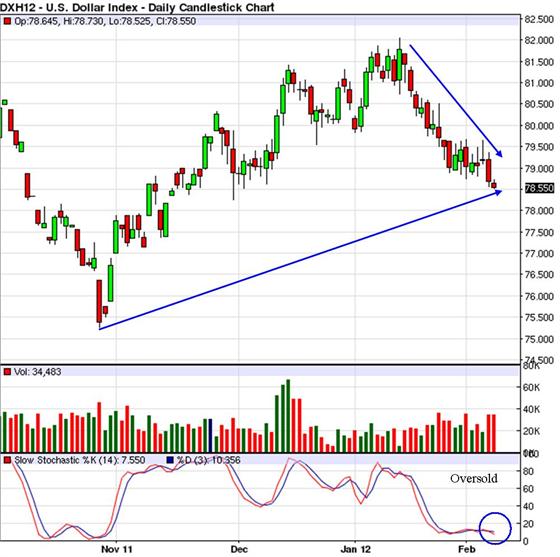Agronomist Notes
Hello Reader
Client and industry meetings with key discussions on sprayers, fertilizer, seed, and our high yield wheat and barley projects have been keeping me busy lately. Fertilizer prices have softened up with urea selling at $600 per tonne, MAP at $790, potash at $650 and AMS at $440. We’re busy finalizing seed purchases with Stettler and Utmost in the hard red spring wheat category, 5700 and 5702 for CPS, Champion and Austenson for feed barley and Midas and Meadow for yellow peas. They’re not all new varieties but are the top performers within my group of clients.
This week I’m writing to you while on vacation in Canmore, AB, hence the tardiness of this issue. Today, we’ll be talking about our magnesium trials set for 2012 and a new concept to apply nitrogen in our CTF system. We’ll finish with technical grain market news.
Have a great week.

Magnesium trials set for 2012
Use grain quality as your fertility guide
Some clients and I were reviewing yields, proteins, and grain quality while discussing crop nutrition plans for next year. One field in particular was repeatedly delivering high yields but low protein. During the conversation, the results of a barley silage analysis taken from an adjacent field were mentioned. The test recommended a magnesium supplement for their cow herd’s diet. Curiously enough, when they added the supplement they had a lot less trouble at calving time. This new perspective got me thinking about the role of magnesium as a protein builder and its effect on grain quality.
Please note if you’re a diehard base saturation ratio believer, soil test follower or plant tissue test devotee, this article won’t float your boat.
The historical soil test data for the field revealed the base saturation level of magnesium hovered between 9% and 11% which is considered ideal. A plant tissue sample that revealed high levels of magnesium at late tillering. Both the soil test and tissue test failed to tell us what the silage sample revealed: a) magnesium demand is highest from stem elongation to full head emergence in cereals, not at tillering when we normally tissue test, b) soil tests do not indicate if magnesium can fall into solution fast enough to match plant uptake, and c) there is no perfect base saturation ratio nor is there a practical method of balancing ratios if one were to exist.
I had a great conversation over email with Jerry Stoller, founder of Stoller USA who knows plant nutrition inside and out. I asked him what the right time was to apply magnesium to match crop needs and here are the tips he provided:
There are normally two times when magnesium insufficiencies are critical.
1. It is usually critical during the first stages of plant growth. Deficiencies can normally show up when there are 2 to 3 leaves emerging on the barley or wheat plant. The foliar application of magnesium may be applied with post emergent herbicide or nitrogen solution. Approximately 2 pounds per acre of magnesium should be sufficient at the vegetative stage.
2. Magnesium is extremely necessary to transfer sugars from the plant cells to the phloem tissue. This is usually referred to as “phloem loading”. This is particularly important when the time the seed head emerges onward through grain development. Jerry suggests the foliar application of magnesium during the period when late season fungicides are normally applied immediately before seed head emergence.
3. Magnesium deficiency is particularly acute on soils that have very high levels of potassium and calcium. It may occur on cold soils where root growth is impaired.
4. Late season deficiencies will normally occur during periods when the demand for sugar translocation from plant cells to phloem tissue is greatest. This is normally when night time temperatures are higher than normal. Magnesium deficiency is less of a problem if night time temperatures are cool.
5. High concentrations of ammonium (from nitrogen fertilizers) and hydrogen ions at the root
surface and within the cytoplasm of cells can also cause magnesium deficiency in acid soils.
One of the most economical sources of magnesium is KMag from Mosaic which contains 11% magnesium, 22% potassium and 22% sulphur and sells for roughly $770/T. Application rates vary so as a rule of thumb you should be applying enough to supply 15 to 30 lbs/ac of magnesium to wheat, barley, peas and canola. Another option is to foliar feed between 0.5 and 2 lbs/ac as magnesium sulphate which is what we plan on doing at late tillering and full head emergence on wheat, barley and canola this year.
If your soils are low in magnesium, high in calcium, potassium or have pH’s below 6, CEC’s under 15 or have high manganese levels, perhaps you should look at doing some magnesium trials of your own this year. SL
Thanks again to Jerry Stoller for his clear and detailed response to the topic. For more facts on magnesium visit here.
Side dressing nitrogen in a controlled traffic farming system
The Hagie Nitrogen Toolbar
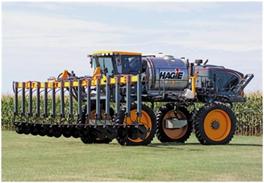 One of the most inefficient but common methods of applying top dressed nitrogen is to use a streamer bar or dribble band liquid UAN with the sprayer. This method of applying nitrogen is inefficient because there is always a percentage lost to volatilization and even more to immobilization. What isn’t lost in the process is reliant on rainfall to wash the nitrogen into the soil to make available to plant roots.
One of the most inefficient but common methods of applying top dressed nitrogen is to use a streamer bar or dribble band liquid UAN with the sprayer. This method of applying nitrogen is inefficient because there is always a percentage lost to volatilization and even more to immobilization. What isn’t lost in the process is reliant on rainfall to wash the nitrogen into the soil to make available to plant roots.
The key to improving application efficiency is to side dress nitrogen, putting it directly into the ground, beside the roots and away from the surface where it can be tied up or lost. For Mitch, Sam and I, our controlled traffic system gives us the option of side dressing nitrogen between the rows, in-season with minimal to no crop damage at any stage of the growing season. To kick it up a notch, we’d like to utilize a side dress nitrogen system coupled with GreenSeeker’s competitor the Ag Leader OptRx system to apply variable rate nitrogen on the go. How do you like the sounds of side dressing variable rate nitrogen on the go in wheat, barley or canola? If I were a smoker I would need a cigarette right about now.
The solution that fits best is the Hagie NTB system which is a quick attach nitrogen toolbar for the front of a Hagie sprayer like the one you see in the photo. The NTB toolbar uses a set of coulters that inject liquid nitrogen on the go at rates up to 80-100 lbs/N/ac at speeds of 14-16 mph! That’s twice the speed of any pull type side dress unit on the market. What I like most is that it eliminates the need for a tractor and separate side dress toolbar.
Have a look here at the Hagie NTB side dressing nitrogen in corn.
The Hagie NTB system comes with 30-ft, 40-ft, 45-ft and 60-ft toolbars on 20-in, 22-in or 30-in rows. We would look to purchase 30-ft x 22-in rows to allow us to move in between our 24-in centres. Ideally we would run a 60-ft NTB system but that’s not in the budget. Brand new the NTB 30-ft x 30-in toolbar retails for $40,000 but I did find a 2009 NTB 30-ft x 30-in for $18,500USD.
Let’s look at the economics of owning the Hagie NTB system with a 30-ft x 22-in row toolbar. Let’s budget $25,000 for the NTB system and assume 28-0-0 UAN is $0.62/lb with a side dress nitrogen application rate of 40 lbs/N/ac.
Steve’s quick math
40 lbs/N/ac as 28-0-0 × $0.62 lb = $24.00/ac
25% N loss from tie up and volatilization
Hagie NTB toolbar: $25,000
25% efficiency gain × $24.00/ac = $6.00/ac
In this example, if we could gain a 25% increase in nitrogen uptake efficiency from side dressing nitrogen with the Hagie NTB versus dribble banding we could generate a return on investment within one year on a 4,000 acre farm. If this were a 60-ft machine and double the price, a 4,000 acre farm would see an ROI within two years. This is solely based on nitrogen savings alone and not yield, protein gains or reduction in lodging from the proper rate and timing of side dressed nitrogen.
The nitrogen side dress system would work really well in a CTF, inter-row system like ours and the Hagie NTB system fits in nicely to our precision platform. However, I would argue that anyone who can inter-row seed and run temporary tram lines with the sprayer could begin to side dress nitrogen. If you start adding up nitrogen savings, yield, protein and quality gains then side dressing could be the way of the future. It already is in my mind! Check out the links below on the Hagie NTB. If you have any comments, please reply to this email. SL
Hagie NTB Specifications manual
OptRx crop sensing variable rate nitrogen on Hagie NTB
Pictured above: www.hagie.com
Market News
Technicals
Canola Nov12: The long term trend is down and the short term trend is up.
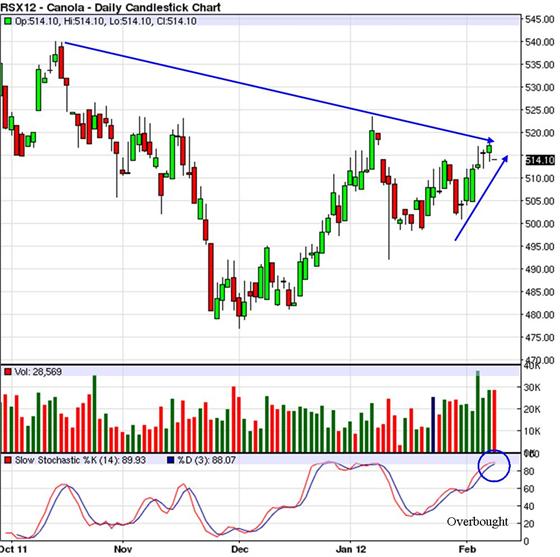
Wheat Dec12: The long term trend is down and the short term trend is up.
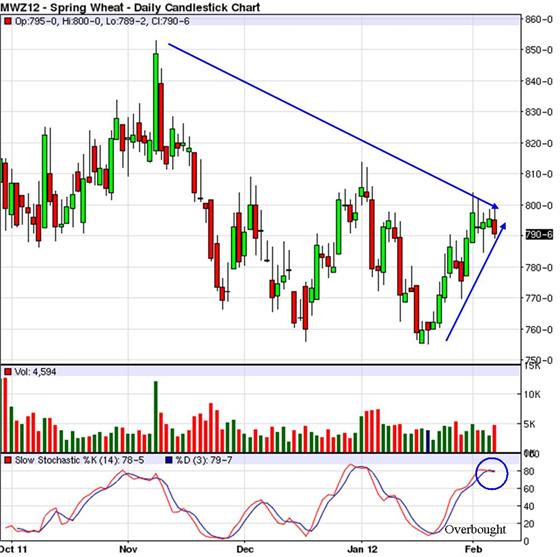
Corn Dec 12: The long term trend is down and the short term trend is up.
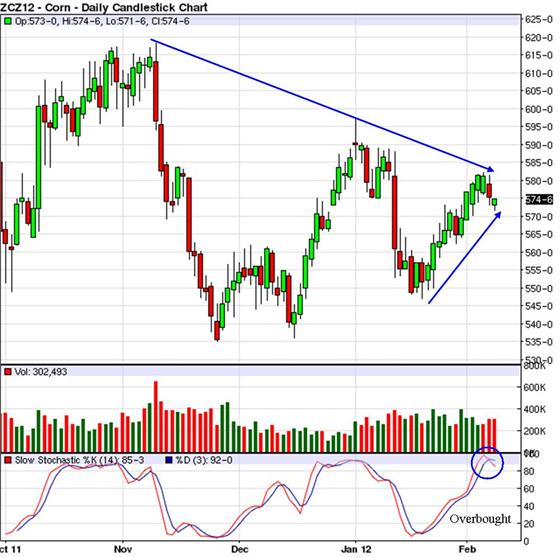
Soybeans Nov12: The long term trend is flat and the short term trend is up.
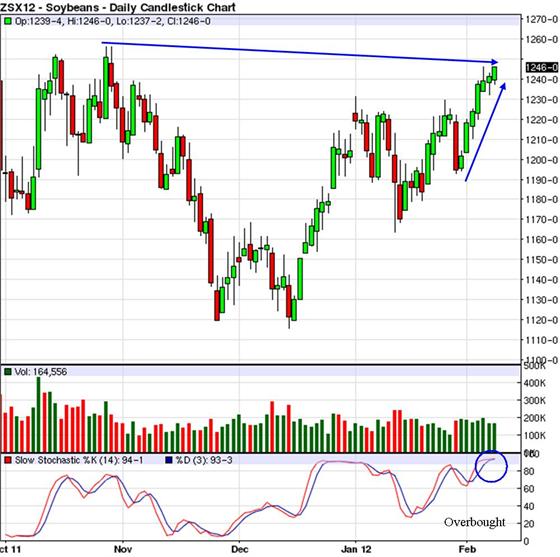
CDN$ Feb12: The long term trend is flat while the short term trend is up.
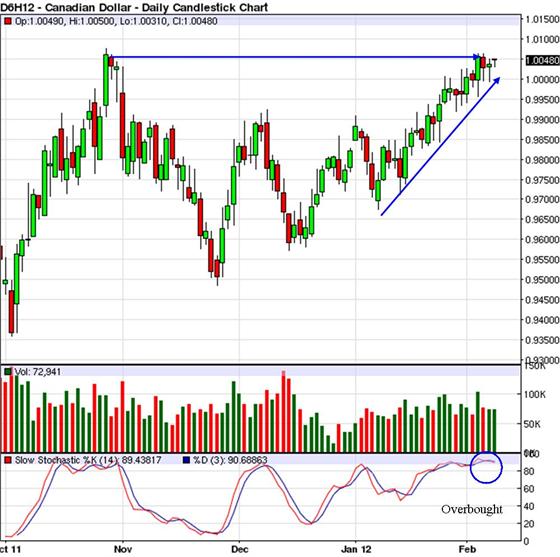
USD Feb12: The long term trend is up and the short term trend is down.
